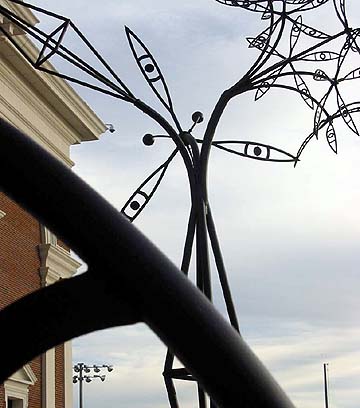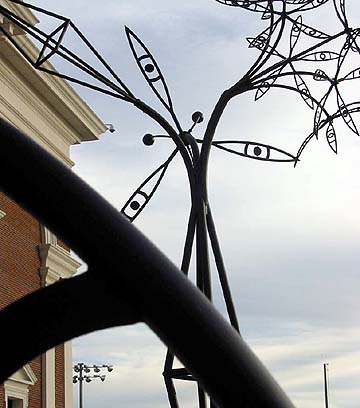
Wood, steel make for ‘fine art’ sculptures
“Creative individuals need an audience,” sculptor James Surls said to an attentive crowd at Meadows Museum last Thursday night. The artist presented an insightful lecture on the inspiration and creation of his sculptures, drawings and prints.
Meadows is showcasing more than 60 works by the sculptor. Most of his work was created especially for the museum’s exhibition called, “Recent Sculpture, Drawings and Prints of James Surls.”
“His work is very organic and springs from a central core that is active and engages its audience,” division of art chair Jay Sullivan said.
The internationally renowned Texas artist is best known for his dramatic large-scale sculptures. Working primarily in wood and steel, Surls creates colossal pieces incorporating repeating images of flowers, needles, houses, diamonds, knives and eyes.
Surls begins his creative process by writing a poem. After completing the poem, Surls draws a picture of the vision he has for the sculpture. He then centers the sculpture on his poem’s core idea. He often titles his drawing and final product the same.
Surls’ first poem was inspired by a trip to Jamaica. Inspiration for other works has come from childhood memories, growing up in Texas and nature.
“Tornado” is a wood sculpture of a log house with a tornado twirling through the roof. Surls’ idea for the piece originated from his childhood days chopping wood.
“An art history class didn’t teach me how to chop wood,” Surls said.
Surls credits his days roaming Texas when he was young for his knowledge of nature and her resources. Most of his natural materials come from the ground after falling from trees or bushes.
“I’m the Will Rogers of wood; I’ve never met a piece of wood that I didn’t like,” Surls said about his material collecting process.
Surls was born in Terrell in 1943. He received a bachelor’s degree from Sam Houston State University and a master’s from the Cranbrook Academy of Art.
He taught sculpture at SMU in the early ’70s. Surls moved back to Houston to teach at Houston University.
While teaching sculpture in Houston, Surls began questioning his life’s purpose and happiness. He spontaneously decided one day to quit his teaching job to find his peace.
He decided to create a sculpture to represent his station in life. “Me and the Butcher Knife” demonstrates the emotional pain he felt. The piece was personal therapy for Surls and helped him make positive changes in his life.
After this tough time in his life, Surls began creating sculptures for a living. Surls feels he found his place through sculpting. His art began making him feel happy and free again. Soon, his pieces began to focus on a more ideal world.
“I’m not ready to throw in the towel on idealism,” Surls said.
The sculptor feels that his art does not fit under one primary genre. Instead, Surls allows his emotions and past experiences lead the way when he is sculpting. Surls’ creative process cultivates many different themes and labels for his work by critics.
“Artists have to be willing to lay their heads on the social cutting block,” Surls said. He feels that society often criticizes the art world and artists must be willing to get knocked down occasionally. If not Surls said, they “don’t belong in the ring.”
Surls has become the lord of his ring exhibiting all over the world. His works are on display in museums across the United States including Museum of Modern Art, the Guggenheim, and the Dallas Museum of Art.
Sullivan said Surls’ pieces displayed on the museum’s plaza are powerful because of their scale and visual appeal.
“Overall, the show is impressive because of its physical energy,” Sullivan said.
Surls’ exhibit concludes the Meadows Museum’s year-long “Celebration of Sculpture.”

Wood, steel make for ‘fine art’ sculptures









